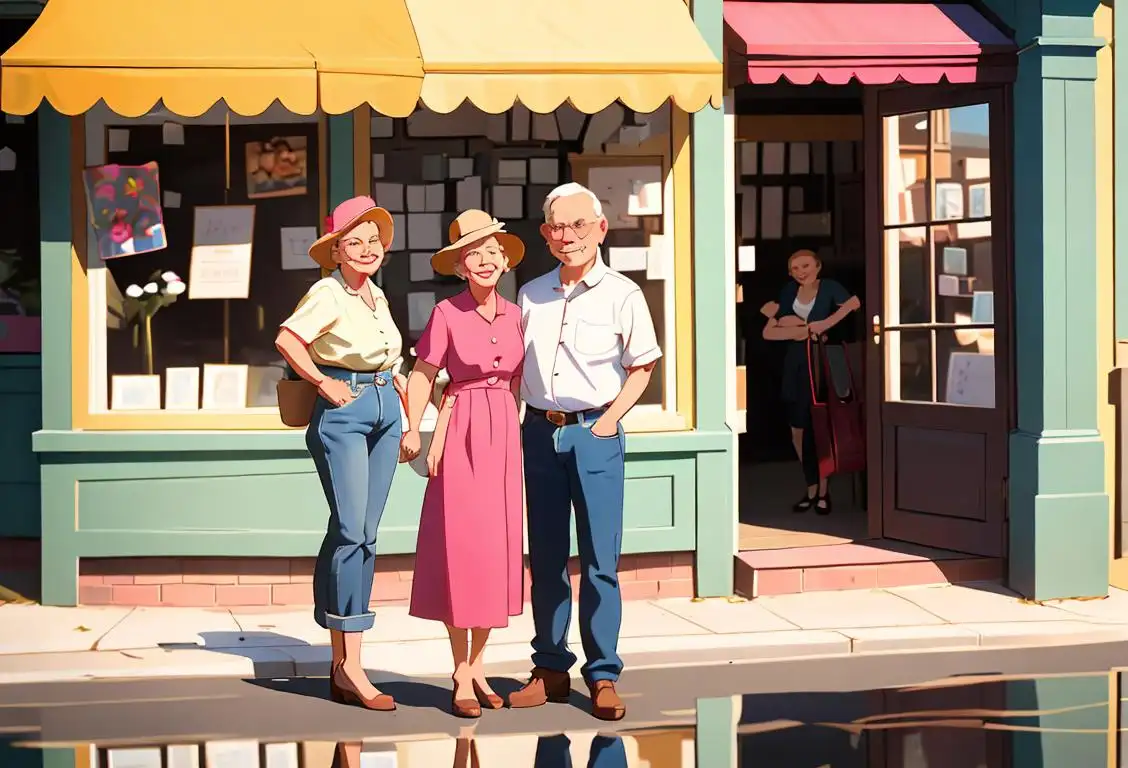National Mom And Pop Business Owner Day

Hey there! Are you ready to celebrate National Mom and Pop Business Owner Day? It's time to pay tribute to those small, family-owned businesses that bring charm and character to our communities. So, grab your wallet and get ready to support local entrepreneurs on this special day!
When is Mom And Pop Business Owner Day?
It's national mom and pop business owner day on the 29th March.
The Internet and the Rise of Mom and Pop Businesses
In today's digital age, it's hard to imagine a time without online marketplaces and big-box retailers. But let me take you back to a time when small, independent businesses were the heart and soul of every neighborhood. Back then, the internet wasn't as prominent, so if you wanted to find a unique gift or have a personal shopping experience, you had to visit your local mom and pop shop.
But with the advent of the internet, many small businesses faced new challenges. They had to adapt to the new digital landscape or risk being left behind. Thankfully, some savvy entrepreneurs saw the potential in e-commerce and used it to their advantage. They created online stores and started promoting their unique offerings through social media and online advertising.
Today, mom and pop businesses have found their place in the digital realm, combining the best of both worlds. They're able to reach a wider audience while still offering that personal touch that sets them apart from big corporations. And that's worth celebrating on National Mom and Pop Business Owner Day!
Fun Fact: Local Mom and Pop Businesses and the Community
Did you know that supporting your local mom and pop businesses not only benefits the owners but also helps your community thrive? When you shop at a small business, more of your money stays within the local economy. It supports local jobs, local suppliers, and local taxes. Plus, it gives your neighborhood a unique and vibrant character that makes it a better place to live.
So, on this special day, make it a point to explore the mom and pop businesses in your area. Whether it's a cozy coffee shop, a charming bookstore, or a delightful boutique, show them some love. You might just discover hidden gems and build meaningful connections with the owners and fellow patrons.
Tags: Loved Ones, Fun, Finance
History behind the term 'Mom And Pop Business Owner'
1920
The Rise of the Independent Business
In the early 1920s, following the end of World War I and the subsequent booming economy, small independent businesses started to flourish. These family-owned and -operated businesses became increasingly popular and were commonly referred to as 'mom and pop shops,' emphasizing the personal touch and familial atmosphere. The term 'mom and pop' was used to describe small retail stores that were typically run by a married couple or a family.
1930
The Rise of Small, Family-Run Businesses
During the 1930s, in the midst of the Great Depression, the economic landscape in the United States began to change. With the closure of larger corporations and factories, many individuals turned to entrepreneurship as a means of employment. Small, family-run businesses started popping up all across the country, offering a more personalized and community-oriented approach to commerce.
1930s
The Rise of Small Family Businesses
During the Great Depression in the 1930s, many people turned to starting their own businesses as a means to support their families. These small, family-owned businesses were typically run by a husband and wife, with the children often helping out as well. These businesses provided a personal touch and were known for their friendly customer service.
1800s
Origins of the term 'mom and pop'
During the late 1800s, the terms 'mom and pop' emerged as informal shorthand for 'mother and father.' It symbolized the family unit and conjured images of small, close-knit families working together to run their businesses.
1900
Post-War Entrepreneurship
After the end of World War II, many soldiers returned home to start their own businesses. These small-scale ventures were often managed by married couples, with the husband handling the technical aspects while the wife managed the administrative work. This dynamic led to the term 'mom and pop' being used to reference these family-run enterprises.
1900
The Rise of Small Family Businesses
In the early 1900s, small family businesses began to emerge as a vital part of the American economy. These businesses were typically owned and operated by a married couple, with the husband handling the business side and the wife helping with bookkeeping and administration. They were known for their personalized service and face-to-face interactions with customers.
1800s
The Rise of Retail
During the late 1800s, the industrial revolution was in full swing, leading to the growth of cities and the expansion of the middle class. As more people moved to urban areas, the demand for goods and services increased. Small, family-owned businesses started to flourish, including shops and stores run by married couples or family members. These businesses were often the backbone of local economies, providing personalized service and a sense of community.
1865
The Rise of the Corner Stores
After the Civil War, many Americans migrated from rural areas to urban centers. In the late 1800s, corner stores began to emerge as a convenient place for local communities to purchase their daily necessities. These small family-owned businesses were often operated by couples, with the husband running the store and the wife assisting in various roles, such as bookkeeping and customer service.
1891
Introduction of the 'mom and pop' shops
The term 'mom and pop' originates from the late 19th century when small, family-owned businesses started to flourish. These businesses were often run by married couples, referred to as 'mom and pop,' who handled every aspect of the operation, from customer service to inventory management. These shops provided personalized and friendly service, fostering a sense of community and trust among customers.
1900
Rise of Small Family Businesses
At the turn of the 20th century, small family-owned businesses began to flourish. These businesses, often run by couples, gained popularity due to the growth of urban centers and a desire for personalized and specialized services. These businesses were typically operated out of the family home and provided a wide range of goods and services to their local communities.
1920
Introduction of 'Mom and Pop' as Terms of Affection
The term 'Mom and Pop' started to gain popularity in the 1920s. It became a term of endearment used to describe small family-owned businesses. These businesses were often run by a married couple, hence the reference to 'Mom' and 'Pop.' The term reflected the intimate nature of these enterprises and the personal touch they provided to their customers.
1920s
Rise of the chain stores
During the 1920s, chains stores began to expand rapidly, offering a wide range of products at affordable prices. This development posed a challenge to the mom and pop shops, as they struggled to compete with the buying power and extensive advertising of these large organizations. However, many customers still preferred the authentic and personal experiences offered by the smaller businesses, leading to their continued presence in local communities.
1900s
World Wars and Post-War Prosperity
In the early 1900s, the world faced the turmoil of two world wars. Many men were conscripted into military service, which led to women taking over the responsibility of running businesses. These women often partnered with their husbands or other family members, creating a system of small, independent ventures known as mom and pop businesses. These businesses played a crucial role in supporting the war effort and sustaining local economies during challenging times. After the wars, the post-war economic boom further fueled the growth of mom and pop businesses as people revved up consumer spending.
1950
Post-World War II Growth
After World War II, there was a surge in suburban growth and the establishment of suburban communities. This led to an increase in demand for local businesses that catered to the needs of these growing neighborhoods. 'Mom and pop businesses' continued to thrive during this period, providing essential goods and services to their communities. The term became even more ingrained in popular culture, representing the close-knit, community-oriented nature of these businesses.
1920s
Growth of small family-run businesses
In the 1920s, with the rise of the industrial revolution and the growth of large corporations, small family-operated businesses became more prevalent. These businesses were often managed by the parents ('mom and pop') and their children, creating an intimate and personal touch in their operations.
1940s
The Emergence of Mom and Pop Stores
In the 1940s, the term 'mom and pop' started to gain popularity to refer to these small family-owned businesses. The term was originally used to convey a sense of familiarity and warmth, highlighting the personal connection between the business owners and their customers. Mom and pop stores became staples of local communities, offering a wide range of products and services.
1920
The Popularization of the Term
The term 'mom and pop' gained popularity in the 1920s. It was used to describe small, family-owned businesses that were seen as a stark contrast to larger corporations. The term emphasized the intimate and personal nature of these businesses, which often operated out of small, neighborhood shops.
1920
Rise of Chain Stores
During the 1920s, large chain stores began to dominate the retail landscape. These corporations had standardized operations and expansive resources, driving many smaller, independent businesses out of the market. As a result, 'mom and pop' businesses became a symbol of local, personalized service, contrasting with the impersonal nature of chain stores.
1940
The Term 'Mom and Pop' Gains Popularity
In the 1940s, the term 'mom and pop' began to be used to describe these small-scale, family-owned enterprises. The phrase tapped into the common perception that these businesses were often operated by a married couple or a family unit. 'Mom and pop' became a widely recognized term for these independent ventures, emphasizing the personal touch they brought to their communities.
1920
The 'Mom and Pop' Term Emerges
In the 1920s, the term 'mom and pop' started to gain popularity in reference to small business owners. The phrase was coined to evoke the image of a friendly, family-run establishment where the owners were intimately involved in the day-to-day operations. 'Mom and pop' businesses became synonymous with personalized service, attention to detail, and a sense of community.
1930s
The Great Depression and the endurance of mom and pop shops
The Great Depression, which hit the global economy in the 1930s, deeply impacted businesses worldwide. However, mom and pop shops managed to adapt and survive during this challenging era. Their ability to provide essential goods and services at reasonable prices, along with their close ties to the local community, helped them weather the storm better than many larger establishments.
1950s
The Growth of Suburban Mom and Pop Shops
In the 1950s, with the rise of suburbanization, mom and pop businesses began to flourish in suburban areas. These businesses catered to the needs of the expanding suburban communities, offering convenience and personalized service. Mom and pop shops could be found in various industries, including grocery stores, hardware stores, diners, and more.
1950s
Suburbanization and Chain Stores Rise
The 1950s marked a significant shift in the retail landscape. With the development of suburban areas and the rise of automobile culture, big chain stores and shopping malls started to dominate the American retail industry. Despite this shift, mom and pop businesses remained prevalent in local communities, providing unique products and services that catered to a more personalized shopping experience.
1950
Post-War Boom and Community Engagement
In the post-World War II era, small businesses experienced a surge in popularity and success. The economic boom coupled with the desire for personalized service led to increased patronage of mom and pop businesses. These businesses became pillars of their communities, fostering a sense of trust and familiarity among their customers. The personal relationships formed between business owners and customers became a defining characteristic of mom and pop businesses.
1950
The Post-War Boom
Following World War II, there was a significant increase in small businesses owned by couples. Many veterans started their own businesses with the support of their spouses, leading to a surge in mom and pop shops across the country. These businesses played a crucial role in revitalizing neighborhoods and providing employment opportunities.
1950
The Rise of Chain Stores
During the post-World War II economic boom in the 1950s, large chain stores began to dominate the retail landscape. These corporate giants often offered lower prices and wider selections, challenging the survival of mom and pop businesses. However, some family-owned stores managed to thrive by emphasizing their unique character, niche offerings, and personal connections with their customers.
1950
Community Support
In the 1950s, the concept of 'shopping local' started gaining popularity. Communities began to recognize the pivotal role played by small, family-owned businesses in sustaining local economies and preserving the unique character of their neighborhoods. The term 'mom and pop' became associated with these local heroes who contributed to the prosperity and unity of their communities.
1950
The Cultural Impact of Mom and Pop Businesses
By the 1950s, mom and pop businesses had become an integral part of the fabric of American society. These establishments played a vital role in creating close-knit communities, fostering loyalty among customers, and supporting local economies. Due to the personalized service and attention to detail, they often developed a loyal customer base, resulting in their continued success.
1940s
'Mom and pop' as a term for small business owners
In the 1940s, the phrase 'mom and pop' began to be used colloquially to refer to small business owners. It became a popular way to describe independently owned and operated businesses run by families, highlighting their distinctive character and the personal connections they formed with their customers.
1970
Corporate Dominance and the Resurgence of Small Business
During the 1970s, there was a growing concern about the dominance of large corporations and their impact on local economies. This led to a renewed interest in supporting small, locally owned businesses. The term 'mom and pop business owner' became synonymous with the idea of supporting independent businesses against the influx of corporate chains. In this context, the term carried a sense of authenticity, personalized service, and a dedication to the local community.
1950s
Post-war resurgence and suburban growth
After World War II, suburban areas started to experience significant growth. Mom and pop shops played a crucial role in these communities by providing convenient and personalized shopping experiences for families. They served as social hubs, where neighbors gathered, shared stories, and built relationships. These small businesses embodied the American Dream and the values of hard work, independence, and community support.
1970
The Resurgence of Small Businesses
In the 1970s, there was a growing recognition of the importance of supporting local economies and preserving communities' cultural identity. This led to a resurgence of interest in mom and pop businesses. Small businesses were seen as a way to combat the homogenization of retail and foster a sense of individuality and community pride. This movement prompted consumers to actively seek out and support local, family-owned establishments.
1950s
Cultural impact and nostalgia
During the 1950s, the term 'mom and pop' gained significant cultural impact. It became synonymous with warm, nostalgic feelings of small-town charm, personalized service, and the sense of community associated with independent businesses. 'Mom and pop' businesses became an essential part of the American social fabric.
1960s
The Challenge of Chain Stores
The 1960s marked a period of intense competition for mom and pop businesses as large chain stores started to dominate the retail landscape. The ability of chain stores to offer lower prices and wider selections posed a significant challenge for the smaller, independent businesses. However, many mom and pop stores continued to thrive by focusing on niche markets, emphasizing quality over quantity, and providing exceptional customer service.
1970
Threats from Chain Stores
In the 1970s, the rise of chain stores and large retail corporations posed a threat to mom and pop businesses. These smaller businesses struggled to compete with the economies of scale, marketing power, and convenience offered by larger companies. However, the term 'mom and pop' gained sentimental value as people recognized the importance of supporting local and independent businesses.
1960s
The Rise of 'Mom and Pop' Terminology
During the 1960s, the term 'mom and pop' gained popularity as a way to describe small, family-owned businesses. The phrase evokes an image of a friendly, neighborhood shop run by a married couple or close family members. The term became widely used to differentiate these smaller, independent ventures from larger chain stores and corporations. 'Mom and pop' came to represent the idea of local, personalized service, and a connection to a close-knit community.
1960
The Challenge of Chain Stores
In the 1960s, the rise of chain stores and larger corporations posed a significant challenge to mom and pop businesses. These chains offered lower prices and greater convenience, making it harder for small businesses to compete. However, many consumers still recognized and valued the unique charm and personal touch provided by mom and pop establishments, helping them thrive in the face of increased competition.
2000
The Digital Age and the Revival of Mom and Pop
With the rise of e-commerce and online shopping in the early 2000s, small businesses faced new challenges in competing with larger retailers. However, there was also a renewed interest in supporting local businesses, creating a resurgence of mom and pop stores. The internet provided a platform for these small businesses to reach a wider audience and maintain a personal touch. Today, the term 'mom and pop business owner' symbolizes the resilience and entrepreneurial spirit of small business owners in the digital age.
1970
Diversification and Resilience
During the 1970s, 'mom and pop' businesses faced challenges from larger chains, economic recessions, and changing consumer preferences. In response, many business owners diversified their offerings and adapted to meet the evolving needs of their customers. The term 'mom and pop' came to represent the resilience, ingenuity, and unwavering spirit of these independent entrepreneurs.
1970
Challenges from Corporate Chains
During the 1970s, mom and pop businesses faced challenges from the rise of large corporate chains and franchises. These chains offered convenience and lower prices, posing a threat to the more intimate mom and pop establishments. However, many consumers continued to support local businesses due to their unique offerings, personalized service, and the desire to contribute to the local economy.
Present
The Modern Mom and Pop Business
Today, mom and pop businesses continue to play a vital role in local economies and communities. Despite facing increased competition from online retailers and large corporations, small business owners adapt and find innovative ways to connect with customers. The term 'mom and pop' has come to symbolize the spirit of entrepreneurship, perseverance, and the authentic human touch that can only be found in these beloved family-run establishments.
1990
Resurgence and Nostalgia
In the 1990s, there was a resurgence of interest in mom and pop businesses. People began seeking out unique and authentic experiences, which these small businesses often provided. The term 'mom and pop' became synonymous with cozy, nostalgic establishments that offered personalized attention, homemade goods, and a sense of community.
1980s
Increased competition and corporate dominance
As the 1980s rolled around, the rise of large corporations and the proliferation of shopping malls brought about increased competition for mom and pop shops. These businesses faced challenges in keeping up with the changing retail landscape, including rising rents and the need to invest in technology to stay competitive. Despite these difficulties, many mom and pop businesses found ways to adapt and survive by emphasizing their unique qualities and niche markets.
Present day
Continued relevance of 'mom and pop'
To this day, the term 'mom and pop' persists as a way to describe small, family-owned businesses. It carries connotations of authenticity, personalized service, and the idea of supporting local economies. Despite the dominance of larger corporations, 'mom and pop' businesses continue to play a vital role in communities around the world.
Present
Revival and Nostalgia
In recent years, there has been a renewed interest in supporting local businesses and embracing the nostalgia associated with 'mom and pop' establishments. Consumers have come to appreciate the personal touch, unique products, and personalized experiences provided by these small businesses. The term 'mom and pop' continues to evoke warm sentiments and an appreciation for the individuals behind these beloved enterprises.
2000s
The Resurgence of Support for Local Businesses
In the early 2000s, there was a growing movement to support local businesses, including mom and pop stores. Consumers started recognizing the value of shopping locally, as it helps to stimulate the local economy, preserve unique products and services, and build a sense of community. This renewed interest in supporting mom and pop businesses has led to the establishment of annual events like Small Business Saturday, dedicated to promoting local shopping.
1980
Resurgence and Nostalgia for Mom and Pop Businesses
In the 1980s, there was a resurgence of interest in mom and pop businesses. As people started to long for a sense of community and a more personalized experience, they began to appreciate the importance of supporting local, independent ventures. This renewed interest led to a wave of nostalgia for the mom and pop stores of the past, as people recognized their significance in preserving local identity and fostering a sense of belonging.
2000
Resurgence of the Mom and Pop Culture
In recent years, there has been a resurgence in the appreciation for mom and pop businesses. Consumers are actively seeking out local, independent businesses to support. This shift is driven by a desire for a more personalized experience, a sense of community, and a recognition of the cultural and economic benefits that small businesses bring to their neighborhoods. The term 'mom and pop' now represents a symbol of local pride and resilience.
Present
Celebrating the Spirit of Small Businesses
Today, the term 'mom and pop business' carries a positive connotation, representing the tenacity, dedication, and personal touch of small business owners. It celebrates the entrepreneurial spirit of couples or families who pour their hearts and souls into their businesses, bringing character and diversity to local economies.
Present
The Everlasting Significance of Mom and Pop Businesses
Even in the present day, mom and pop businesses continue to be valued for their unique character and contribution to local economies. They provide personalized services, unique products, and a sense of community. While often facing challenges from larger corporations and online retailers, these small businesses persevere and thrive due to their strong local support. The term 'mom and pop' remains a symbol of these treasured family-run ventures, representing the spirit of entrepreneurship and community engagement.
Present day
Resurgence and appreciation for local businesses
In recent years, there has been a resurgence of appreciation for mom and pop businesses. Consumers are increasingly seeking out locally-owned establishments for their personalized services, unique products, and contribution to the local economy. Websites and social media platforms supporting small businesses have gained popularity, allowing these shops to reach a wider audience and compete with larger retailers. The term 'mom and pop business owner' now symbolizes the spirit of entrepreneurialism and community-building that continues to thrive in today's society.
Did you know?
Did you know that supporting your local mom and pop businesses not only benefits the owners but also helps your community thrive?Tagged
fun loved ones financeFirst identified
29th March 2015Most mentioned on
29th March 2021Total mentions
44Other days
Awareness Day
One Day
Action Day
Opposite Day
Seniors Day
Veterans Day
Happiness Day
Bison Day
Suicide Prevention Month Day
Family Day









